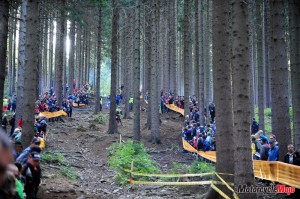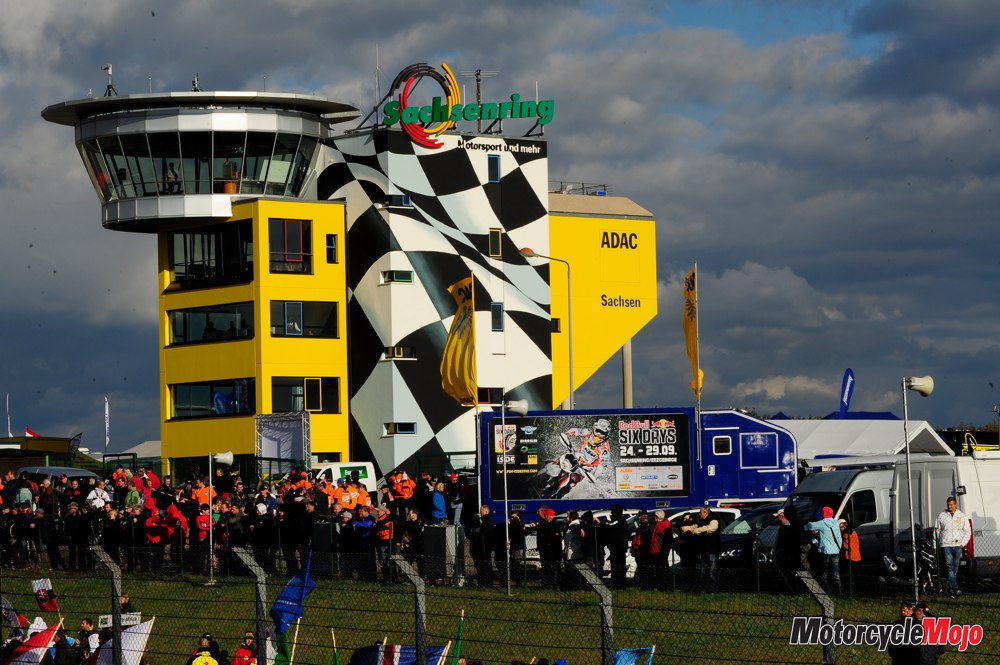As the morning mist burned off the trees outside the castle wall of the hotel in Chemnitz, Germany, last September, it was tough to tell what Mother Nature was conjuring up for the start of the Red Bull Six Days Enduro competition. My time in Germany to that point offered anything and everything – from warm, sunny skies to overcast and blustery fall winds – all in the same day. As the day went on, Mother Nature put on a good show.
When Red Bull becomes the title sponsor of a sporting event, you have got to know it will be challenging, exciting and like nothing you have seen before. For several days leading up to the start, for instance, German television news couldn’t stop talking about Felix Baumgartner, the skydiver who jumped to the ground from outer space – sponsored by none other than Red Bull. The space jump plan came about after X-Games’ Travis Pastrana successfully jumped from a plane without a parachute and free-fell until being caught by parachuted guards – again, brought to you by none other than Red Bull. Nuts! And that is exactly what the ISDE is – nuts!
To set the tone of the event, Red Bull air-race pilot Matthias Dolderer put on one incredible show, flying some amazing aerobatics, while BMW stunt rider Chris Pfeiffer tore up the track. Pfeiffer’s skill and talent far surpasses that of any stunt rider I have seen to date, and he entertained the crowd riding a BMW F800R. At one point, he was riding his motorcycle vertically on the rear wheel, turning circles, with one hand on the ground and the other on the throttle.
 Admittedly, I was a rookie Six Days goer and had no idea what to expect. I had heard of the race and read the history, but none of that could have prepared me for what I would see in person. Hearing or reading about the event is nowhere near the same as actually witnessing it.
Admittedly, I was a rookie Six Days goer and had no idea what to expect. I had heard of the race and read the history, but none of that could have prepared me for what I would see in person. Hearing or reading about the event is nowhere near the same as actually witnessing it.
Thirty-six countries were represented; Canada fielded two teams – six riders in total. From a sea of 700 global riders, 21 were women, two of whom were from British Columbia and one – Victoria Hett – from my Okanagan backyard.
The men, Patrick Tremblay of Quebec, Mark Dzikowski of Alberta and Brad Winchell of Powell River, B.C., made up the Canadian men’s club team, while Alberta’s Amber Giroux and Almeda Rive would round out the Canadian Women’s World Trophy Team with Hett. Rive and Hett were previous ISDE teammates, having competed in Morellia, Mexico, in 2010, but Giroux was just as green to the event as I was.
What was in store? Just 1450 km of riding on roads, through fields, up mountains and through mud pits, some motocross courses in farm fields, plus some enduro challenges like tree roots, tires and logs thrown in. Then add a timer. For some reason, I thought the event would be on a closed circuit, but as we drove through the small villages in the Chemnitz area, residents walked their children to school, pushing baby strollers and grocery carts, as riders were whizzing by from behind, leaving the road for dirt trails, showing up again at intersections and going in all directions, making it tough to figure out who was leading.
 A map outlined the course, complete with GPS coordinates in longitude and latitude, but it was still tough to get your bearings. Never in a million years would I have seen the small villages, or the history that the former East Germany offered, had it not been for this competition.
A map outlined the course, complete with GPS coordinates in longitude and latitude, but it was still tough to get your bearings. Never in a million years would I have seen the small villages, or the history that the former East Germany offered, had it not been for this competition.
After chasing riders around for most of the morning on Day 1, my husband and I came to the conclusion that we could never audition for television’s The Amazing Race if we wanted to stay married another 20 years. We were having navigational issues that included the odd argument, while the British lady in the dashboard kept politely asking us to “please make a U-turn.” What did she know?
Honestly, I enjoy getting lost, but my husband prefers to have a plan. The map was marked with Special Test (ST) sections, Time Check (TC) sections, and Interesting Points (IP) for the fans. IP was closest, so we reprogrammed the GPS, took a few correct turns upon the advice of our British lady friend in the dashboard, and found ourselves roadside with hundreds of parked cars but no people. As soon as I rolled down my window, though, the roar of fans, air horns and whistles coming from the woods confirmed the correct location – and an impending hike.
From the road, it appeared to be woods, but from the woods, it was a straight-up hike with hundreds of fans lining both sides of a rutted, tree root–riddled mud trail which riders attempted to climb at top speed. If they didn’t make it in one shot, it was back to the bottom to try again. This type of terrain would best be tackled standing on the bike, but the hill angle and difficulty of the hazards had every rider seated, feet floating free for balance.
Police and emergency vehicles were prevalent, but other than spectating, they didn’t appear to be doing too much. An ambulance did arrive at “Devil’s Hill” when one rider was ejected from his bike and rolled to the bottom with what appeared to be a broken collarbone. All riders would navigate this climb four times during the first two days and 540 km of the race, each attempt more challenging than before as bikes dug up the terrain and Mother Nature added a sprinkle of water here and there.
At the end of each day, riders must impound their bikes. Impound times are based on start times. The fenced path to the impound lot, called a parc fermé, is usually lined with fans as riders walk their bikes toward the gates. Several polizei stood at the entrance, and I originally thought they were there for security. Several officers stood by as one sergeant cross-checked his list of numbered riders with those heading to impound, and pulled specific numbers aside. On the spot, riders were issued tickets for running red lights, speeding through villages and passing on the right, among other infractions, and fines were required to be paid right there and then. Cash. No points on your licence.
When I saw the Canadian ladies walking out of impound, filthy and smiling, it really hit home how hard they were working to represent their country (even though greatly outnumbered by our neighbours to the south), doing what they love and making sporting history.
On Day 3, Giroux, the smallest of the ladies, riding in wet and muddy conditions, lost her bearings in the mud, put her foot down for balance and got her boot stuck in a tree root, ultimately pulling her groin and eliminating her from the race. Rive was also pushing as hard as she could with fatigued muscles and an incredibly sore wrist. By day’s end, she had ridden past her allotted time and was retired from the race. As the rules state, teams are allowed to restart one rider, so Rive took another shot the following day, but with severe wrist pain, she could not keep within the time restrictions and was eliminated.
By Day 5, 13 of the 21 ladies who began the event remained in competition, and Hett was ranking in 9th place. “I would like to finish in the top ten,” she had told me when I asked her about her goal for the event during the opening ceremonies.
Hett had something to prove. She entered the competition as the first-ever Canadian woman to complete an ISDE event. In 2010, in Morelia, Mexico, she competed until the race was called on Day 5 due to drug-cartel shootings that took place too close to the route. Despite remaining in the race until that point, she felt somewhat cheated for not being able to compete the full six days. Hett is a skilled independent rider, but without major sponsors, continuing her competition year after year is next to impossible. Hett was unable to compete in 2011 in Finland for financial reasons, but kept up her training and set her sights on Germany.
In Germany, the lead female rider, Ludivine Puy of France, out-rode Hett with speed and experience, being 10-plus years Hett’s senior.
“There are some fast riders out there,” said Hett. “I try to keep up with them, watch them and learn anything I can from them.”
Day 6 would wrap the competition with the shortest day and a supermoto-style track race to the finish line. France triumphed in the women’s category, a cumulative 1 hour 52 minutes ahead of second-place finisher and event host, Germany. Hett finished, earned a bronze medal and is now officially the first Canadian woman ever to complete the International Six Days Enduro competition and earn a top-ten finish.
Persistence and determination is what has kept the women’s team going for the gold. The Canadian Women’s Trophy Team is committed to compete for the next five years, finances permitting. The Canadian Men’s Club Team is also intent on a 2013 attempt.
What could be new in 2013? Team manager Mike Kelly said he would like to bring a Junior Trophy Team to compete as well. They say that once you have taken part in an ISDE, you’re hooked. There may be some truth to that.
The 2013 competition host country was announced in Germany. The beautiful sands, ocean and weather of the island of Sardinia, Italy, from September 30 to October 5, is where riders from around the world will converge and compete in 2013. I fully intend on being there, but this time, I won’t be so green.




































